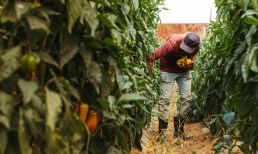Exclusive: AgriDex Bets Stablecoins Will Transform $2.7 Trillion Ag Market
Despite being a $2.7 trillion global industry that underpins human survival, the global agricultural trade’s supply chains remain tangled in outdated systems, high fees and lengthy settlements.
“There is a huge amount of friction in global trade, especially in emerging parts of the world,” AgriDex CEO Henry Duckworth told Karen Webster. “You can fix that with the digitization of contracts and easier payments.”
The company’s newest product, Loam, is a USD-backed stablecoin payment rail designed to cut settlement times, reduce transaction costs and bring more transparency to cross-border agricultural transactions. Through Loam’s web-based platform, exporters can manage payments, process invoices and complete trades with little more than a smartphone and an internet connection.
“Even if you’re in the bush in the middle of Central Africa, why do you need to pay DHL to fly your documents all the way to the end buyer on the other side of the world?” Duckworth said. “Why not just do it all through your computer or mobile system?”
In a world where food security is increasingly entangled with climate change, geopolitical instability and broken trade routes, the financial plumbing that underpins global agricultural trade could be overdue for responsible disruption.
To start the transformation, AgriDex is focusing first on a specific set of users: exporters who have already been vetted through existing compliance regimes.
“We’re not starting from scratch,” Duckworth said. “These are established farmers and producers who already work with banks, buyers and regulators. They’ve cleared the major licensing hurdles. We are just giving them better tools.”
Trust Is the Key Currency of Blockchain Innovation
At its core, Loam is a USD-backed stablecoin payment rail that uses smart contracts to enforce transactions under English company law, helping to mitigate risk in jurisdictions where currency volatility and shaky legal systems might otherwise scare off institutional investors.
“Instead of going to a local bank to spend a lot of money turning your local cash into a U.S. dollar… you can jump over that by simply logging onto Loam, uploading your documentation, passing your KYB and engaging with your end traders,” Duckworth said.
However, as with any blockchain-powered innovation, the technology is not the hard part. Building end-user trust is. Convincing farmers and buyers to abandon their long-standing habits and adopt a blockchain-based payment system requires more than a clever user experience. It requires boots-on-the-ground literacy campaigns and incentives that speak to immediate pain points.
“We often work with older farmers who are naturally cautious, and we tell them, ‘Just test it with a smaller trade flow and a buyer you already know,’” Duckworth said. “Once they see the benefits of cheaper and faster payments, they come back. Your sellers can get you better quality products faster if you engage in a system that pays them fairer.”
For buyers, the enablement and acceptance incentive is simple but powerful: a forex arbitrage. In markets like South Africa, Loam users, for example, can gain up to 2% on USD conversion compared to traditional routes, which can provide an edge that matters, especially in low-margin businesses.
Infrastructure and the Leapfrog Effect
Still, as blockchain infrastructure continues to grow and mature, it is becoming increasingly clear that payments are just the tip of the iceberg. Many sector observers see the biggest long-term opportunity in on-chain credit, where Web3 capital can meet a need for working capital in underbanked regions.
“There is a dearth of credit to some really amazing producers, exporters and traders in the region,” Duckworth said, noting that Web3 investors, with their higher risk appetite, could fill that gap.
“It’s not about throwing money around recklessly but about backing vetted businesses that just need liquidity,” he said. “Buyer beware, but there’s an amazing opportunity here.”
This opportunity is best understood through the lens of the “leapfrog effect.” In much the same way that mobile phones allowed many developing countries to skip over the landline era entirely, blockchain and decentralized finance have the potential to leapfrog traditional financial systems.
As for the macro environment shaping stablecoin adoption, Duckworth said he is cautiously optimistic.
“We are going into a multi-currency world,” he said. “American dominance as a singular point of currency is going to be declining. Whether it snaps or ratchets down 1% every year remains to be seen.”
He said he believes Europe could lead the charge with a digital euro, forcing businesses to adapt.
“Some people just don’t get the tech, and that’s OK,” Duckworth said. “I still remember my granny didn’t want to use cellphones for the first 10 years. Now, she can’t live without it.”
For all PYMNTS digital transformation coverage, subscribe to the daily Digital Transformation Newsletter.



